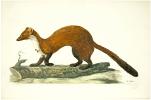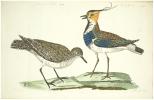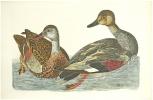The British Zoology, Class I. Quadrupeds.
Eur 48,000 / USD 55,200
The price shown on each item does not include V.A.T (Value Added Tax). As a result of the recent EU legislation we are required to charge our EU customers the percentage of V.A.T. charged by the customer’s country of residence, unless they possess a V.A.T. registration number. Postage Additional.
II. Birds. Published under the inspection of the Cymmrodion Society, instituted for the Promoting Useful Charities, and the Knowledge of Nature, among the Descendants of Ancient Britons, illustrated with one Hundred and seven Copper Plates. London, J. & J. March, (1761-) 1766. Large Folio (520 x 350mm). With 132 engraved plates after M. Griffith and P. Paillou, executed by P. Mazell and handcoloured by P. Paillou (only this first edition). Title page in red and black. Contemporary calf, richly gilt decorated spine with gilt lettering, richly gilt decorated sides, gilt turn-ins, gilt edges (ends of spine joints splitting but sound).
The first coloured illustrations of birds in a book which attempted to list and portray all the British species, many of them life-size
A splendidly bound copy of the First edition. "The first coloured illustrations of birds in a book which attempted to list and portray all the British species, many of them life-size? Peter Paillou contributed most of the designs and coloured the prints, the colour being extended to the trees, branches, and foregrounds. These really splendid folio plates cost Pennant so much that the British charity school at Clerkenwell, for which the profits from the book were intended, came off badly, as did Pennant himself. Nevertheless they showed what could be done in the production of good, large pictures of British birds. Much of the credit must go to Mazell, the meticulous and tidy etcher, for his fidelity to Paillou's drawings" (Jackon, Etchings 106).
Very rare first edition, issued in four parts since 1761, the work was to be completed in 1766, with 107 plates and descriptions. In that year, however, a supplement of 25 plates was published. The copies with the supplements bound in, like this copy, are seldomly found, according to Brunet. To the descriptions of each species are added references to other zoological works of the period. 121 plates show birds and 12 quadrupeds.
"Pennant, perhaps the best known of the British zoologists of the eighteenth century, came from an old Welsh family of some distinction? He himself related that his taste for natural history was implanted in him at twelve years of age? It was on the recommendation of Linnaeus that he was in 1757 elected to the Royal Society of Upsala" (Mullens & Swann, A bibliography of British ornithology p. 464). A very nice and beautifully coloured copy.
Provenance: Armorial bookplate of Henry Rogers Broughton.
Nissen IVB, 710; Anker 392; Fine Bird Books p. 99.




























